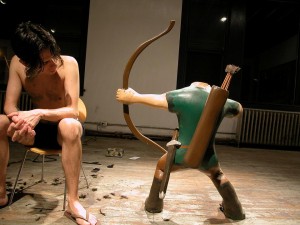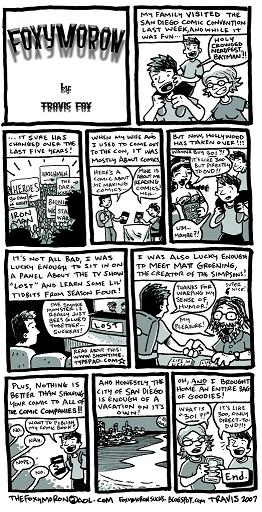
Hector Casanova is an illustrator and comics artist based in the Kansas City area. He is an illustrator and cartoonist for the Kansas City Star, artist of Image Comics’ Screamland, and produces a wide variety of illustration and fine art for various outlets.
You can find out more about him and his work at www.hectorcasanova.net.
Question 1: When did you first decide that you wanted to create your own comics for a living?
I have wanted to draw comics ever since I was a little kid. I didn’t have a TV for most of my childhood, so I had other ways to keep myself entertained. One was to make my own comics. I would fold a bunch of blank sheets of paper in half, staple them together and make a little booklet first. Then I would just go to town and fill them with a comic that I apparently was making up as I went along. I only have vague memories of these, and the plotlines are what you’d expect from a seven-year-old. In one, a mugger would try to mug a guy who turned out to be the Hulk. Bad call. There would be fighting and rampaging, the mugger would get dead and the Hulk out of control, and Spider-Man would end up teaming up with the Dinobots in order to go stop the Hulk, who in the end was only mad at the mugger. That kind of thing. What I would give to have all these original booklets still. I have a few drawings from my childhood in a box, but not many.
Question 2: Who has had the biggest influence on you outside the comics industry, and how did they affect your life?
My mother. It was her idea to get rid of the TV, and she always was very supportive of my “artistic pursuits.” She would let me draw on my bedroom walls, that kind of thing. And she would take me to art museums and ask me to explain t0 her what I liked or disliked about paintings and sculptures. So she had me thinking about art critically before I even understood what an art career really was or could be.
Question 3: Who has had the biggest influence on your comics career, and how has that person changed your work?
Two answers. From an aesthetic and formal point of view, Bill Sienkiewicz. He was the first artist I saw who approached comics from a wholly different angle. He broke my preconceptions of the medium, and through his work I was able to see how much unexplored ground there still is. I’ll always owe him for that.
And from a practical standpoint, it was Tom Dolphens, the Art Director at the Kansas City Star, which is the major daily newspaper in the area. While going to art school, I took one of the classes he taught. Illustration Processes I think it was called, basically a mixed media painting class. After being his student, he gave me my first freelance job doing illustration. Then an internship. Then a full time job as a staff illustrator after school. And the chance to make my own comic strip for the Star. That guy has given me more breaks than… a very breaky thing.

Question 4: What do you do to recharge your creative batteries?
Travel. Friends. Hedonism. Basically I seek out experiences intense enough to make me feel I have something to make art about. My love for making art is only rivaled by love of living life and getting into crazy shenanigans. I’ll go for months without making much art, just goofing off and recharging. And then I’ll go for months barely leaving the studio to go buy food.
Question 5: Describe your typical work routine.
It really depends on what I am doing. The truth is I hardly have any set methodology. For a while it was that I would draw everything pen and ink on paper, then scan that, and finish the colors in Painter and Photoshop. That held true for many years. But even that has come to change now. I keep my process fluid and intuitive. I look at stuff I have made and I only vaguely know how I did it. Sometimes I do most of it traditional — watercolors, ink, etc., and sometimes I will do it all digital. Most of the time it’s somewhere in between. I get bored pretty easily, so I can never stick to a formula for too long. It makes my work look eclectic as hell, like it was done by ten different artists. But for me the pleasure is in the fluid process of making images itself. If I know exactly what I am going to do, then I have already lost interest before I even got started.
Question 6: What writing, drawing, or other tools do you use?
In the last couple years I started using color pencils to sketch. First rough sketch, just trying to get the composition, with a yellow pencil. Then tighten it up with blue or red pencil. And then ink over that with speedball nibs and sumi ink. I like not having to erase the graphite pencil marks — which typically leads to smudging the ink, because I am impatient and need to scan the inked drawing to color it in the computer. The color pencil lines are easy enough to drop out in Photoshop. And then I just mess with it on Photoshop or Painter until it’s done or it is due, whichever comes first.

Question 7: What element of your work gives you the most personal satisfaction?
I am hardly ever satisfied with my work, at least not for long. I am very critical of it, always aware of my mistakes. When I finish an illustration, the honeymoon period of being proud of what did rarely lasts more than a few days before I start fixating on the things I should’ve done differently. I don’t dwell on it, and I move on to the next thing. I have been known to fall into a spiral and not being able to leave something alone. It’s not a good thing to do. Deadlines are good, they force me to walk away.
So, in terms of satisfaction, I do enjoy seeing my work around town, and on different places. I enjoy doing logos and posters for bands, and then seeing my stuff all over, on t-shirts and belt buckles. And I like that by the time it gets to that stage, it’s not about me or my ego, it’s just a — hopefully — arresting image floating around. Just a couple weeks ago, a fan in Engalnd sent me a picture of his tattooo: It was an image from The Lurkers, a comic that I did with Steve Niles. That made my day.
Question 8: What has been the most rewarding project in your professional career – in or out of comics – and why?
Oh man. Nope. I am hoping the most rewarding project is still ahead. Like I said, I am a bad father and I find faults in all my children.
Though I am still proud of the work I did for Screamland. Especially the second half, after I had found my groove and the work was flowing. Some of that is still very pretty to my eyes.
Question 9: We’ve all met very talented newcomers who are trying to get their first professional projects. What’s the best advice you’ve ever heard given to a promising new creator?
Do it for yourself. Set your standards super high, and then try to meet them. Make the kinds of comics that you think the world needs more of. Which typically means not the kind of stuff you grew up on, but instead strive for new ground. People may or may not get it, but if you stick with it, eventually you’ll get somewhere new. I think that applies to any art medium, not just comics.
Question 10: Time to get philosophical: What’s the most important “big idea” that you’ve learned in life – in or out of comics – and why is it important?
Sniff before you nibble. It could save your life.
Also, don’t cross the streams. Or pee on the electric fence, spit into the wind, or poke a bear with a stick.
I think having a balanced life, taking the time to take your mind and heart and body on adventures is essential to making art — and to being happy. You can’t make good art if you don’t have anything to make art about.
Keep up with the comics news from Kansas City.
Like us on Facebook and follow us on Twitter.
 Kevin Mellon has quickly developed a reputation as a top-notch artist, and is now making his move into writing some of his own material. You may have seen his work on GearHead (Arcana), Thirteen Steps (Desperado), Teddy Scares (APE), Ghosting (Platinum), GunPlay (Platinum), Comic Book Tattoo (Image) Antoine Sharpe, The Atheist Vol. 2 (Desperado), Hack/Slash (Devil’s Due), and This Is A Souvenir: The Songs of Spearmint and Shirley Lee (Image, 2009).
Kevin Mellon has quickly developed a reputation as a top-notch artist, and is now making his move into writing some of his own material. You may have seen his work on GearHead (Arcana), Thirteen Steps (Desperado), Teddy Scares (APE), Ghosting (Platinum), GunPlay (Platinum), Comic Book Tattoo (Image) Antoine Sharpe, The Atheist Vol. 2 (Desperado), Hack/Slash (Devil’s Due), and This Is A Souvenir: The Songs of Spearmint and Shirley Lee (Image, 2009).
 We’re blessed here in Kansas City to have a daily newspaper that embraces and supports local cartoonists. For years the Thursday edition of the Kansas City Star has featured the work of talented local creators (Hector Casanova, Josh Cotter, Daniel Spottswood, and Kerry Callen, among others) in a combination of short runs and ongoing features.
We’re blessed here in Kansas City to have a daily newspaper that embraces and supports local cartoonists. For years the Thursday edition of the Kansas City Star has featured the work of talented local creators (Hector Casanova, Josh Cotter, Daniel Spottswood, and Kerry Callen, among others) in a combination of short runs and ongoing features.
